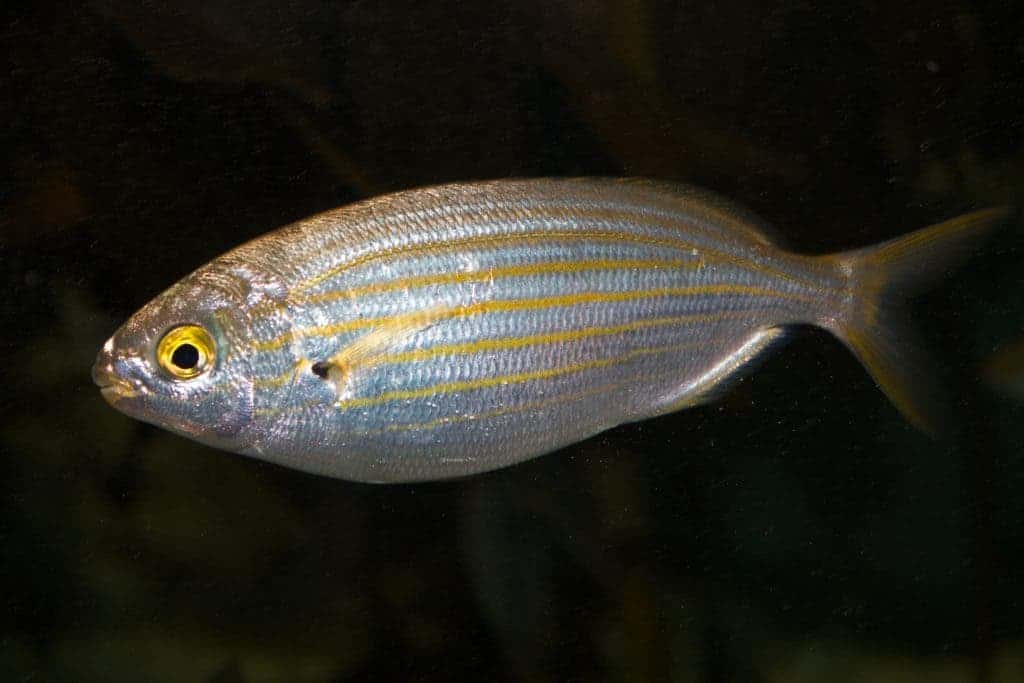
Deep in the Mediterranean Sea, there is a fish unlike any other. This small, inconspicuous fish, holds a nasty secret: its head is riddled with hallucinogenic substances which give people days of vivid, LSD-like hallucinations. Let’s just say that one horrible night after bad sushi is a walk in the park compared to the intoxication of this fish. Meet the salema porgy, the psychedelic fish that has fascinated people for centuries.
A fishy history
The small, golden-striped sea bream lives throughout the Mediterranean and Africa’s East coast, though it was spotted as far north as Britain. Also called dreamfish or salema porgy, it swims up to a depth of 70 meters (230 ft).
For centuries, fishermen in the Mediterranean have known about the salema porgy (Sarpa salpa) and its mind-altering effects. We know the ancient Romans treated the fish as a recreational drug, employing its psychedelic powers during ceremonies. In Arabic, the name of the fish translates to “the fish that makes dreams” so people in the Middle East probably also knew about its hallucinogenic properties.
The body of the fish isn’t toxic or dangerous at all — in fact, the fish is served as a traditional Mediterranean dish, with rosemary and pepper. But if the head is also consumed, then things start to get a bit nasty.
High on fish

Ichthyoallyeinotoxism, or hallucinogenic fish inebriation, comes from eating certain species of fish that contain psychoactive substances, typically from around the tropics area. Ichthyoallyeinotoxism is usually associated with extremely strong, vivid hallucinations, and can be quite dangerous. It’s unclear if the fish themselves produce these toxins or if they somehow pick it up through their diet, and salema porgy is no exception.
The fish gained renewed attention following a 2006 study that examined two cases of men who ate salema porgy on the French Riviera. Both of them had hallucinations, with the authors noting that one man had auditory hallucinations of “human screams and bird squealing,” while the other “was not able to drive anymore as he was seeing giant arthropods around his car.”
“With side effects like obscured vision, muscle shortcoming and retching enduring and declining all through the following day, he cut his excursion off and jumped in the car, just to acknowledge mid-travel that he couldn’t drive with all the shouting creatures diverting him. Disturbance and bewilderment drove him to look for medicinal help (he was not ready to drive any longer as he was seeing giant arthropods around his car),” reads the case study of one of the patients, a 40-year-old man.
Initially, doctors in the hospital’s emergency department weren’t sure what to make of the man’s case since he exhibited no obvious symptoms aside from the hallucinations. Physical examination exhibited no striking anomalies: no fever, no indication of centralization or sensory-motor deficit. The man committed himself to a clinic, where he recovered after 36 hours. To make things even stranger, he couldn’t remember a single thing from this experience.
The other case, just as bizarre, comes from a 90-year-old man. After consuming the fish, he began to experience mind flights of shouting people and screeching winged animals. Unlike the other case, he didn’t tell anyone, instead staying inside his house and toughing it out. Thankfully, the hallucinations faded after “only” two days.
Another rather famous case (which hasn’t been scientifically documented) is that of Joe Roberts, a National Geographic photographer. Roberts wanted to try the dreamfish, so he had a chef broil it, and ate it with stewed pumpkin. He also experienced hallucinations, though they weren’t as vivid, and they weren’t really negative in nature. Roberts was quite happy with the experience.
“It was pure science fiction,” he said. “I saw a new kind of car, steered with a stick like a plane. And then I was taking pictures of a monument to mark man’s first trip into space.”
Making sense of it all

Understanding what makes the fish so trippy isn’t straightforward at all. Since most salema porgy specimens do not produce any hallucinations, toxicity levels may have a seasonal variation. This suggests that the “trippiness” comes not from the fish itself, but from its food sources. Some scientists have linked the salema porgy’s hallucinogenic properties to phytoplankton that develops on the seagrass Posidonia oceanica, but the dietary origin hasn’t been confirmed. To make things even more complicated, only some sections of the salema porgy’s head exhibit toxicity.
As for the toxic agent itself, it could be an alkaloid of the indole group, which is a family of compounds found in certain algae and phytoplankton whose chemical makeup is very similar to the structure of LSD. Alternatively, parts of salema porgy may contain high amounts of dimethlytrypthamine (DMT), the same psychoactive agent responsible for the mind-altering effects of ayahuasca.
The salema porgy is not just known for its hallucinogenic properties, but also for its fascinating life cycle. These fish are herbivores and feed mainly on algae and seagrass. They are also known for their unique mating behavior. During the breeding season, male Salema Porgies will gather in large groups and create nests out of seagrass. They will then perform elaborate courtship displays to attract females. Once a female has chosen a mate, she will deposit her eggs in the male’s nest. The male will then guard the eggs until they hatch.
Ichthyoallyeinotoxin is not unique to the Salema Porgy. It’s also found in other fish species, such as the goatfish and the boarfish. However, there is not enough research yet about the agents that might cause ichthyoallyeinotoxism in fish. One thing’s for sure: if you eat this fish and then find yourself seeing giant arthropods or hearing screeching birds all around you… you’re probably in for a nasty couple of days.






